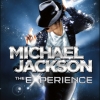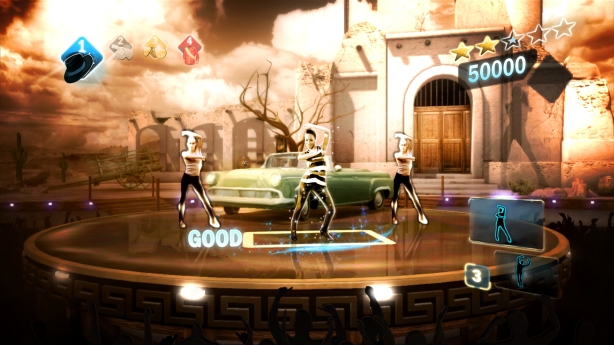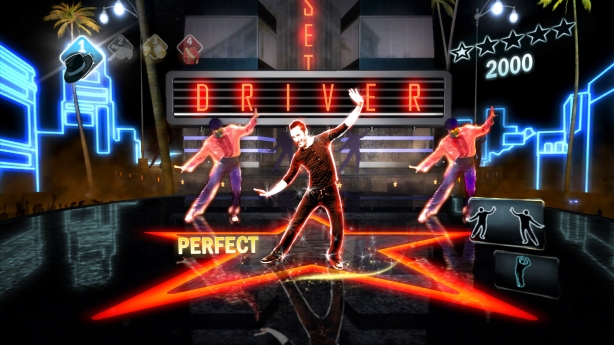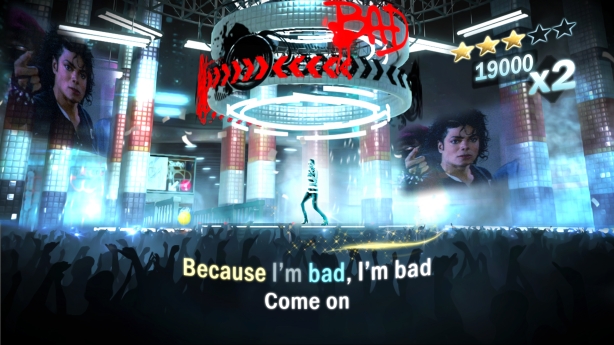Michael Jackson: The Experience Kinect Review
 Game: Michael Jackson: The Experience
Game: Michael Jackson: The Experience
Developer: Ubisoft Montreal
Publisher: Ubisoft
Available On: Xbox 360 (Alternate versions also available on Wii, DS, PlayStation 3, PSP)
If people were to name their favourite singers and dancers, it is highly likely that there is one name that would regularly top their lists. Michael Jackson helped revolutionise pop music as we know it, and for over four decades he was a constant presence in both the music industry and the newspapers. His lifetime album sales and concert revenues are astronomical and there is little wonder why Ubisoft wanted to create a video game based on his music. His song catalogue is a valuable asset and to have access to that is a huge boon for any company. Ubisoft released the “lite” version late last year, which closely mirrored their earlier dance success with Just Dance. Now is time for the main course though, as the Kinect and microphone enabled Xbox 360 version finally hits retail. Was it worth the extra six-month wait? Does it do enough to be crowned King Of Pop?
STORY: Unfortunately users will immediately come up against the first disappointment, there is no story mode. Staggeringly, there are actually no career or tournament modes present in the title whatsoever. With such a rich history in the music industry and such an intriguing lifestyle that he led, a story mode would have been a perfect fit for Michael Jackson. Even if it were to mirror the story style gameplay encountered in The Beatles: Rock Band, where you play gigs in the famous stadiums and locales from the career of the artist, being a part of the iconic performances that helped define them. This mode could have begun with a young Michael in his early performances with the Jackson 5, gradually moving onto his solo Motown career. Then we could transition into the move to Epic Records and the mainstream success that brought us albums like the record breaking Thriller.
You can imagine why Ubisoft declined to feature more of a narrative driven mode. With a life so full of controversy, the developers wouldn’t have wanted to tarnish his image in any way. The later stage of his career was particularly troubled, and maybe they had trouble working out how to weave that into a career-based mode. When playing certain songs we are treated to short intro scenes, such as the underground train station from Bad, a bat-infested picturehouse playing Thriller, or a Rainforest canopy for Earth Song. While they help set the stage, they don’t make up for the lack of a long-term mode of play.
GRAPHICS: If you have played the Wii version of the game, or either of the Just Dance games for that matter, you will be aware of the simplistic, colourful graphics that are used throughout those titles. Stages are simple 2D backdrops and character models are basic, but well-animated, so that the dance moves are easy to follow. For the Kinect release, Ubisoft have gone for a totally different approach however, and have created a new game engine that can exploit all of the features that Kinect affords to a game, and the initial impact is that the visuals take on a much more realistic style. This is partly down to the fact that the kinect sensor is used to project the image of the player into the game. Because of this fact, everything else in-game needs to be of a similar integrity, and it is certainly the most graphically impressive version of the game.
This means that all character models in-game are actually high-quality video of filmed performers. These are obviously skilled dancers, and they are made up and dressed to match the theme of the track being performed, so they fit in well, and because they are filmed, animation isn’t an issue, apart from the rare occasions where a representation of Michael himself appears on-screen to accentuate one of his signature dance moves. The model of Michael is stylised and only appears for a few seconds, so the fact that it clashes somewhat with the regular graphics is not a big issue. It is a nice touch to make players feel like they have really pulled off a difficult manoeuvre that only the King Of Pop could usually perform.
As mentioned previously, each song has a personalised “stage”, which usually involves a short intro leading into an arena where the player stands on-stage to perform their song. These stages are each well themed to the track and give some character to the locations. If they were all simply set on a regular stage, it would be quite plain and uninteresting, so actually dancing in a jungle or bar scene reflects the real music video. Clips from the music videos also play in the background, but these are often obscured by both the performers on-screen and elements of the scenery, so I’m not sure this was such a necessary measure. You certainly don’t pay attention to these clips at all during a playthrough.
SOUND: For a music title, you would expect sound to be top-notch, and this game certainly delivers. The music used has all been reproduced to the highest standards and you could not take issue with any of the recordings, even those from quite early on in the career of the artist. Tracks are re-used throughout menu screens too, along with crowd sounds, used to inject some anticipation and excitement into proceedings. Other than that, there are few incidental sound effects.
When singing tracks, the player has full control over the balance between the volume of their microphone, compared to that of the original vocal track, although this doesn’t seem to work as well as in Singstar, for example. Perhaps it is the use of the Kinect microphone, rather than dedicated mics that causes this, but the issue is a minor one which doesn’t detract from the overall experience, it is just slightly harder to get the volume balance exactly as one might like it, when compared to the slick, well established system employed by Sony in their karaoke games.
GAMEPLAY: Where do you start to talk about the gameplay? Perhaps we should look at the tutorial and practice modes, as any budding young pop star might do. New users can choose to attend MJ School, or to pick a track and try out practice mode. Neither are overly successful, and when compared to another Kinect dancing game such as Dance Central, MJ doesn’t match up favourably. MJ School amounts to a series of around thirty videos, featuring professional choreographers and backing dancers. In theory, the dancers will show you how to perform some of the dance moves from each song. In practice, they move far too quickly for a casual dancer, or worse, to follow. These instructors don’t repeat their steps and barely slow down their routines, making it ridiculously difficult for a novice to take anything from this mode. Fair enough, after you have actually played a track a few times, I found returning to this mode did help me to perfect some of the more difficult moves, but as a learning tool MJ School leaves much to be desired.
As for the practice mode, it isn’t much better. Whilst players will be able to break the dance down into shorter sections when practising, there are no options to reduce the speed of play or to constantly repeat the same move until it is mastered. This is something that was done very well in Dance Central, and players could go over and over a tricky move as much as they wanted, slowing it down, and gradually working their way up to a proper performance. In this title however, the practice mode seems tacked on, and is simply the regular mode, broken down into a few shorter chunks.
The bulk of the game is taken up by the solo dance mode. Twenty-nine songs are present for players to try out, in either dance/sing, performance or master performance mode, each with their own difficulty. Most songs will allow the player to just dance at the simplest setting, then performance will include singing and dancing, and master performance ratchets up the difficulty and speeds up the rate at which moves must be performed. A handful of songs, largely the slower ones, have singing only options, as no choreography has been assigned to that song, and these offer a welcome change of pace, for a more relaxed experience.
The difficulty curve is steep, and as players start to try and mirror the dance moves in even basic dancing modes, they will see that it will take several attempts at a song before they can reach a decent score. Their actions are quite accurately captured, and players will know when they haven’t been matching the moves correctly, so repetition and learning the routines is the key to getting five-stars on each tune. As each move is also performed by filmed dancers on-screen, they are sometimes easier to discern than those in other Kinect dance titles which employ computer-generated character models. When a real person is performing the move, it can be easier to work out exactly how their body is moving. I would say however, that the small icons that flash up to show what dance moves are coming up next could do with being a little larger, so it would be easier to tell one move from another. These icons are also perhaps not as clearly drawn as those seen in Dance Central, for instance, and working out what you need to be performing next can really be a guessing game at some points.
When singing enters the equation, users can either just use the built-in Kinect microphone, or use other singing game mics if they own any. Tested using Kinect only however, the microphone seemed of a satisfactory sensitivity, as long as there aren’t any other background noises in the room. Unfortunately, both in a regular performance game and master performance, play alternates between dancing and singing sections. I assume the developers thought that singing and dancing at the same time would be too hard, but once a player has learned the song thoroughly, a dual mode would have been very rewarding and would have added a greater challenge to proceedings. As it is, the player does one after the other, then back again, and is scored separately for both their singing and dancing, so they can see which section is letting them down.
MULTIPLAYER: Perhaps the biggest missed opportunity in the game is the lack of online features. Let me make this as clear as possible, the game has absolutely no online functionality. Extra tracks will apparently become available at some point, but even this is not integrated into the game interface, instead these can only be bought from the Xbox dashboard. There is no online multiplayer, or even the most basic of connectivity features, like online leaderboards. This leaves local play as the only option in multiplayer gaming.
Games can be played in both battle and co-operative modes, which can both support between two to four players. In co-op, all players take turns to dance and/or sing, hoping to get the highest overall score as possible, whereas in battle mode, two teams face-off in a score duel. The important phrase here is “take turns” though. Even a very mediocre dance game such as Dance Evolution on Kinect showed that two-players can compete head-to-head using the technology, which begs the questions, why do developers insist on making multiplayer modes turn-based. It is assumed that the sensor is more accurate with one user, or that space to dance in would be limited if two players danced side-by-side, but the most enjoyable part of multiplayer gaming is simultaneous competition.
Splitting play down into separate turns does diminish the immediacy and competitive nature somewhat, as it simply becomes a score-beating exercise. Whilst this is still fun in its own right, it doesn’t produce the same level of excitement and silliness that games such as Dance Dance Evolution or Singstar can manage in battle modes.
LONGEVITY: This title is severely hampered by the issues I have already covered. A lack of career mode, tournaments, leaderboards and online competition really limits the lifespan of this title, and with the non-simultaneous offline multiplayer, there is little on offer that will make players come back again and again. Obviously, beating their own high scores to gain five-star ratings on songs, and gathering Achievements will keep players occupied a little longer, but many of the achievements are quite straightforward, meaning that once you have learned the dance moves for a song, users will be able to meet the requirements without too much difficulty. After than is finished, only true MJ fans will keep coming back to the game.
VERDICT: As solid as the dancing and singing experience might be, the game is simply let down by a lack of variety. There are too few modes and options to give the game any real legs. As a party experience, this is a great title, but the lack of any compelling multiplayer options are little disappointing. The game feels rushed, despite the extra six months of development time it received over other console versions. Simply having access to the back catalogue of music from one of the biggest stars in the history or pop is not enough.
Despite all that, you will certainly get a lot of fun out of Michael Jackson: The Experience, and fans of the prince of pop will more than likely adore the title. This game isn’t really “Bad”, but soon enough players will “Beat It” and, done with the title, and sadly it might end up “In The Closet”.










